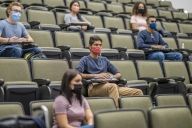You have /5 articles left.
Sign up for a free account or log in.
Outbreaks of norovirus on college campuses in Michigan, Ohio and Pennsylvania in the last month have sickened hundreds of students, and a handful of new cases have recently been confirmed at the University of California at Berkeley.
Miami University of Ohio reached roughly 200 cases by the end of last week, and Berkeley on Tuesday confirmed three of its own with another 26 reports of noro-like symptoms.
Often mistaken for stomach flu, norovirus is a highly contagious but relatively benign infection that can cause stomach pain, nausea, diarrhea and a low-grade fever. Because it’s so easily transferable, however -- via contaminated food or contact with an infected person or surface -- it has the potential spread very rapidly on campuses where many students live in close quarters.
At the University of Michigan, for example, a handful of cases reported over a weekend in mid-February blossomed into more than 150 over the course of the next week and then tapered off to “virtually no new reports” by Friday, according to a university spokesman. Just one student was briefly hospitalized for dehydration, but most simply stayed home for a few days, he said.
“The virus soldiers along from person to person until someone goes to work, and then a lot of people get ill,” said Timothy Moody, chair of Emerging Public Health Threats & Emergency Response Coalition of the American College Health Association and staff physician at California State Polytechnic University-Pomona. “It’s really uncomfortable but otherwise not really a problem for otherwise healthy people.”
Symptoms only last one or two days, Moody said, but even after you feel back to normal, the virus is transmittable for another three or so days.
“Employers and schools need to know they’re putting their patrons at risk if they let people come to work if they’re sick or too soon after they’ve gotten the illness,” Moody said.
Another outbreak that sickened 375 was traced back to the Kellogg Center and State Room restaurant at Michigan State University, according to the Lansing State Journal. And it turned out that nearly all of the 120 students that had been infected with the virus at Boston University in December had visited a nearby Chipotle restaurant.
That’s why it’s important, Moody said, for colleges to encourage hand washing and routinely clean communal bathrooms with bleach.
What’s an Outbreak Like?
Ursinus College, a small, private college in Pennsylvania, runs its wellness center “exactly like a family practice office,” explained the college's medical director, Paul Doghramji.
It’s open 9 to 5 and closed weekends, though Doghramji said he’s personally available any time for emergencies.
The waiting room has just 20 seats, and when Doghramji walked in at 9 a.m. on the first Wednesday in February, they were all full.
“They came in waves after that,” he said. Another 20, then five, then 10 and on and on over the course of a week until nearly 200 of the college's 1,600 students had come down with the disease.
“So many kids got it, and they got it so quickly,” Doghramji said. “It kind of crippled the educational environment. A lot of kids did not attend class. A lot of kids didn’t want to attend class, and a lot of kids didn’t want to go into main areas like the dining hall.”
In response the university doubled its available hand sanitizers, closed the dining hall and advised students experiencing symptoms to keep hydrated and seek medical help and students in general to keep their hands and common areas as clean as possible.
The students maintained relatively good cheer under the circumstances, organizing themselves under the hashtag #ursinusplague.
After a week or so, cases dropped from 20 to 30 a day to just one or two, Doghramji said, though they haven’t disappeared completely as of Friday. In a closed environment like a college, 40 to 75 percent of the population can be affected, he said, and on cruise ships that can get as high as 90. “Ours is about 20 percent, which suggests we got to it quickly, did what we needed to do.”
“It’s a perfect virus for an environment like a college,” Doghramji said. None of the wellness center’s eight staffers ended up getting sick, though, which was a little ray of hope: “If you exercise good prevention methods even if you have close contact, you won’t necessarily get it.”
Mumps
Norovirus isn’t the only disease making its way around college campuses recently. Several have also seen cases of mumps, a viral infection that can cause fever and swelling of the salivary glands.
Nine students were diagnosed with the disease at Butler University in Indiana, another eight cases have been confirmed at the Indiana University campus in Bloomington, and one was reported at Indiana University-Purdue University at Indianapolis, according to the Indianapolis Star.
The University of Kentucky also confirmed three mumps cases with four more possible, pending further investigation, according to a spokeswoman there.
“It’s not a terrible illness,” Moody said, though it can have complications, like orchitis, or swelling of the testicles, “which is not a good thing,” because it can in rare cases lead to fertility problems.
It is contagious, however, spreading through saliva or mucus via coughing, sneezing or even talking, according to the Centers for Disease Control and Prevention. Most college students are vaccinated against mumps because it’s one of the three diseases included in the measles, mumps and rubella, or MMR, vaccine routinely given to children in two doses.
The disease can still spread, Moody explained, because not everyone responds to the vaccine and some colleges either don’t require it or carve out exemptions for international students or parents requesting waivers.
“For mumps we need to have about 95 percent immunity or you have enough people to sustain transmissions,” Moody said.
At Butler all nine students who contracted the disease had been vaccinated, as all students are required to be at the university per state law. The local county health department encouraged students, faculty and staff to receive a booster shot (made available free on campus), noting that the two previous doses were only about 90 percent effective.
So, between norovirus and mumps outbreaks in the last couple months, are these diseases on the rise on college campuses?
Yes and no, said Moody.
Norovirus is a common cold-weather infection sometimes called “winter diarrhea.”
“We see it in the winter usually every year,” he said. “I think [outbreaks] get into the news a lot faster.” Major stories like Chipotle-linked outbreaks make headlines and then “smaller outbreaks that wouldn’t make the news end up on the front page just because they’re related.”
Mumps, on the other hand, may indeed be on the rise, Moody said, “because of the number of people excusing themselves from vaccine requirements.” As that becomes more common, so too will mumps.








